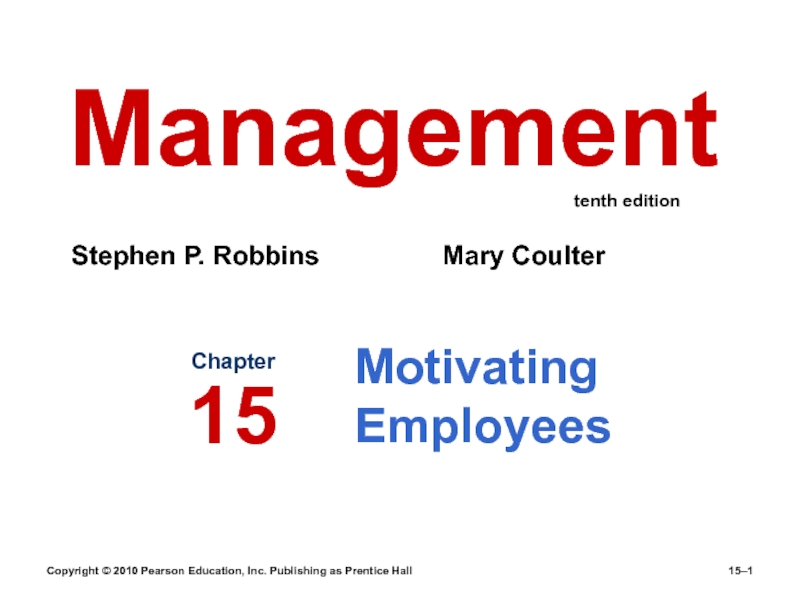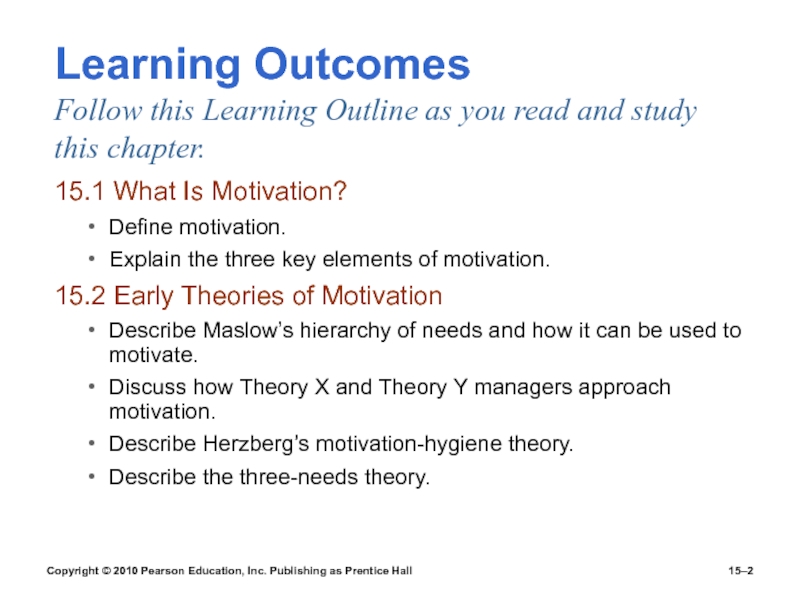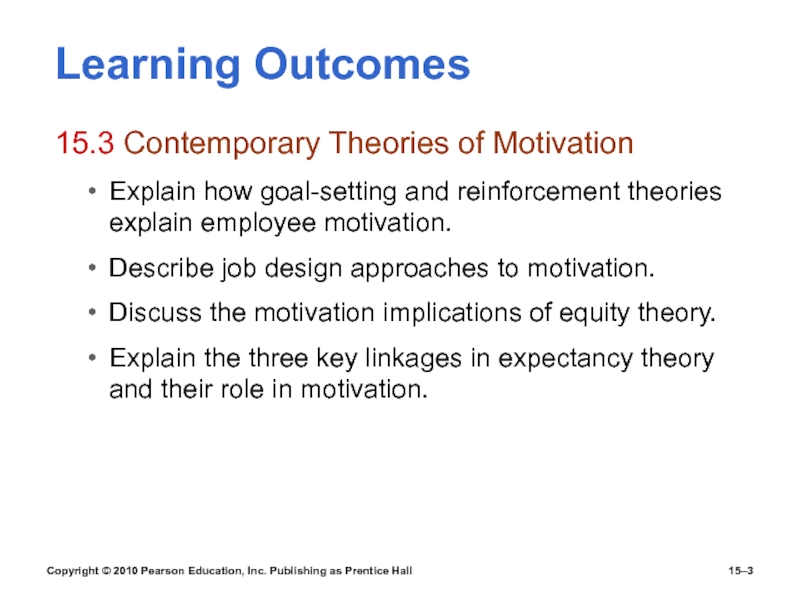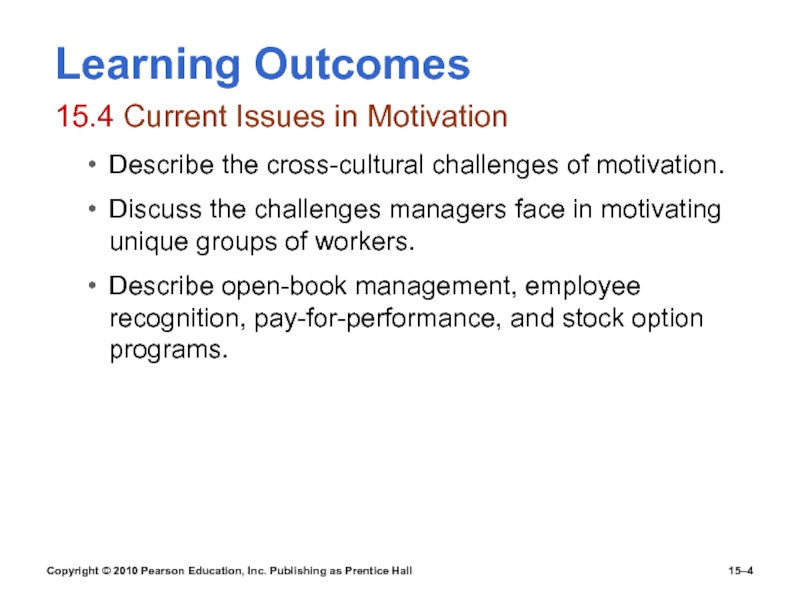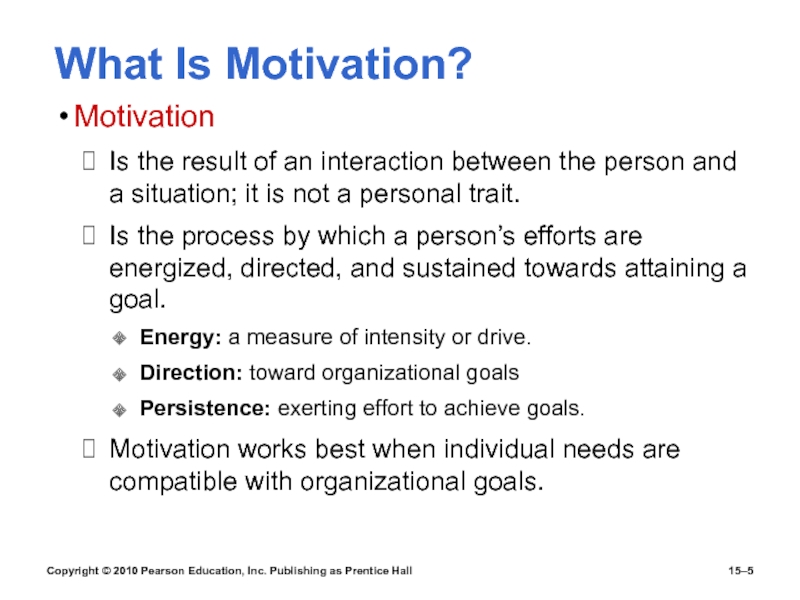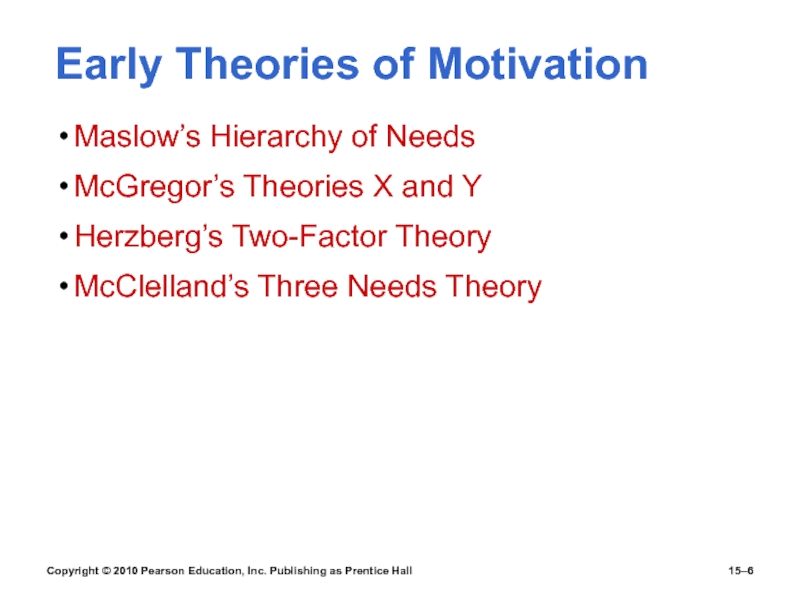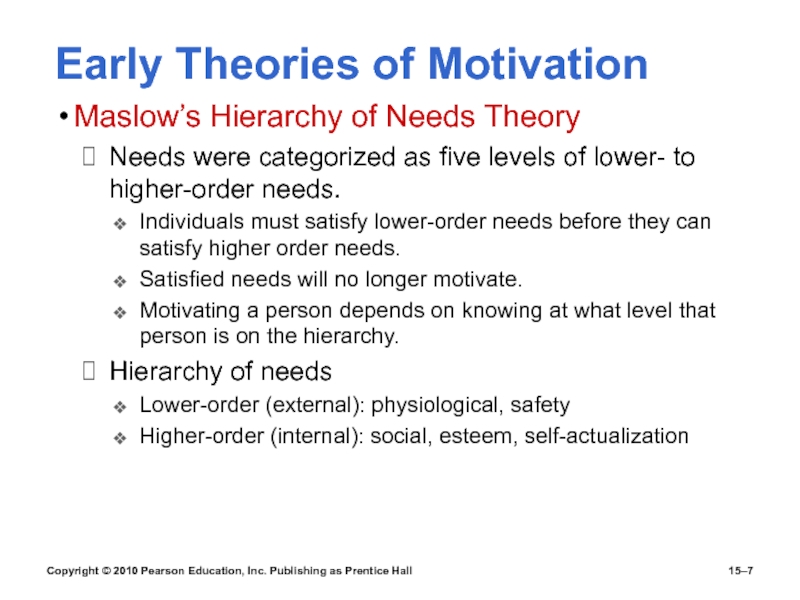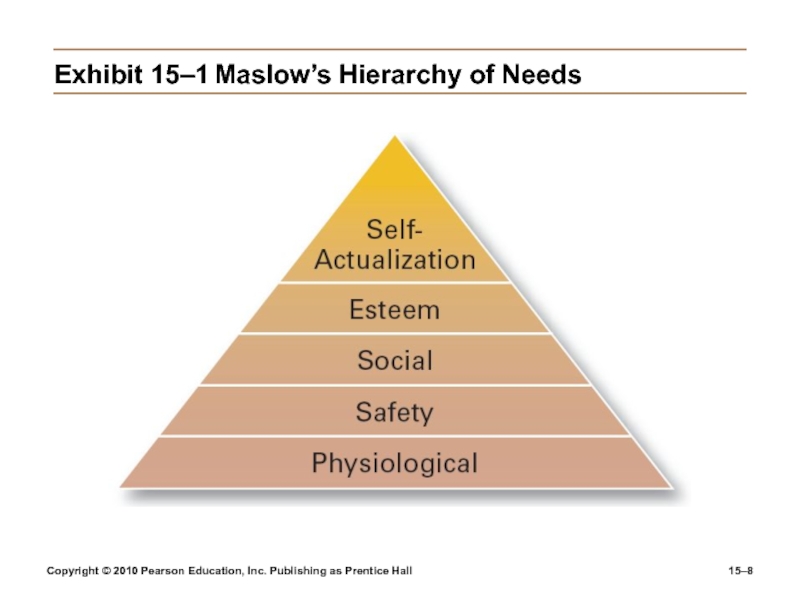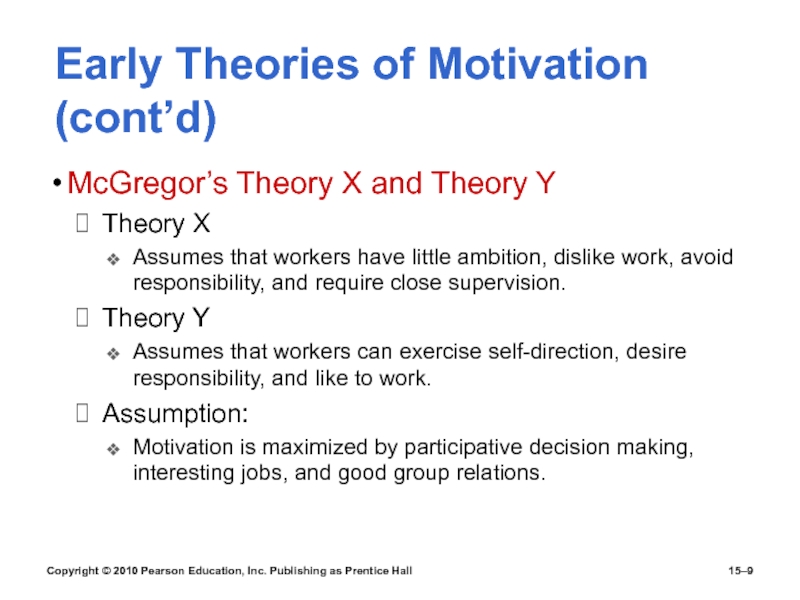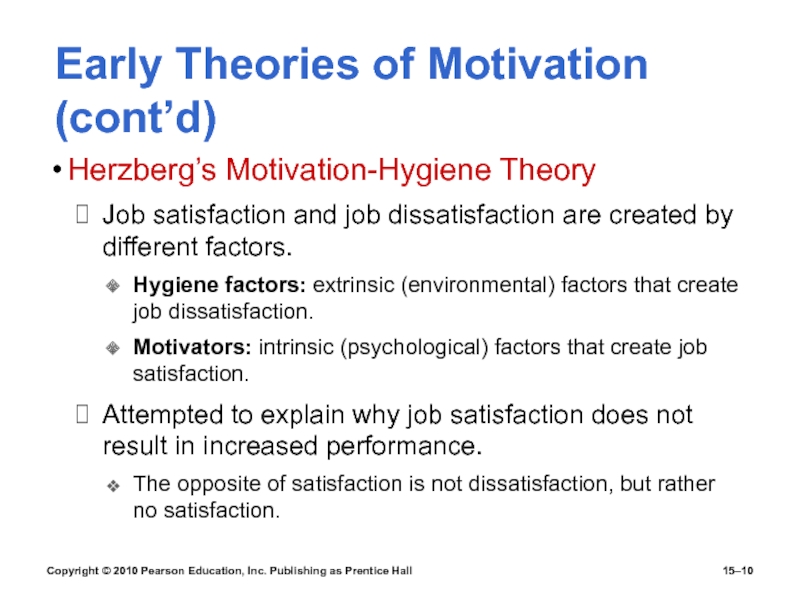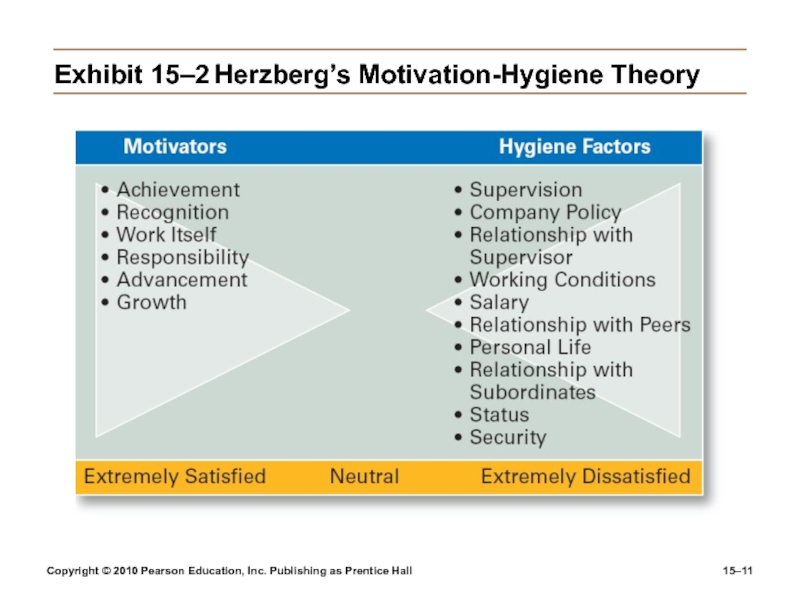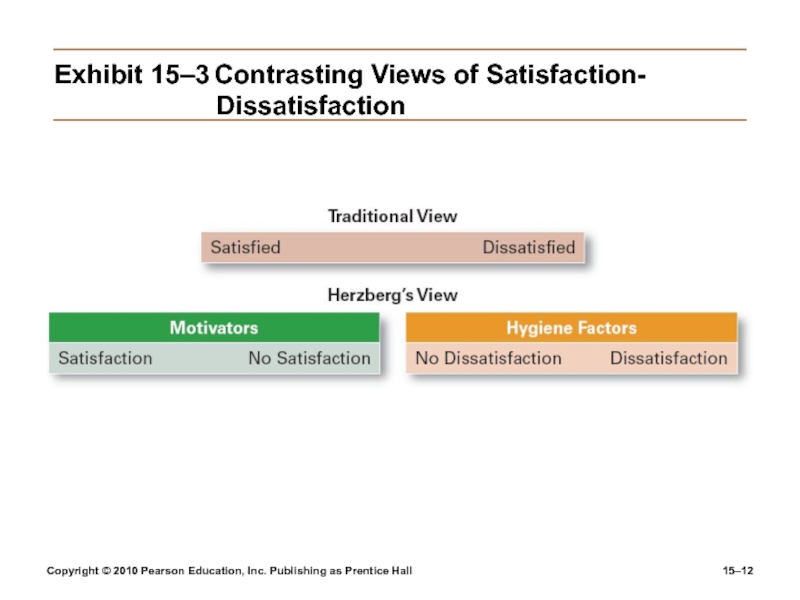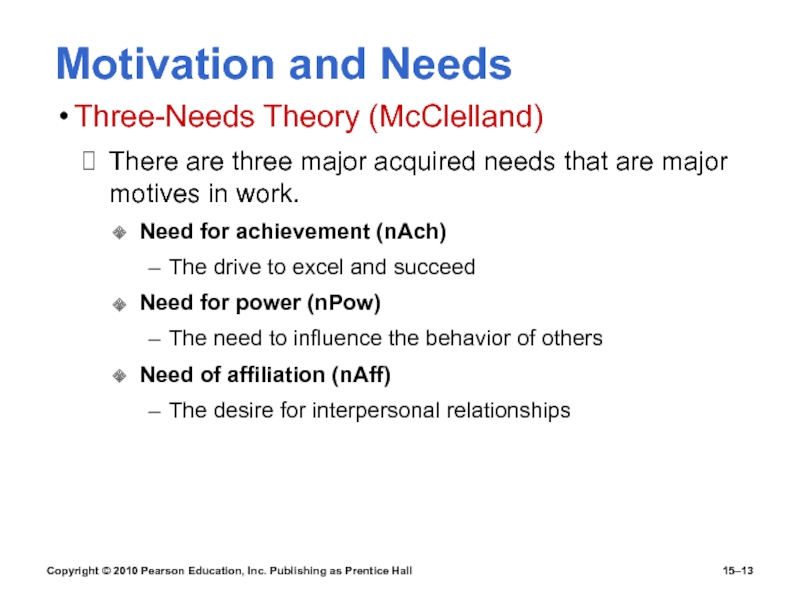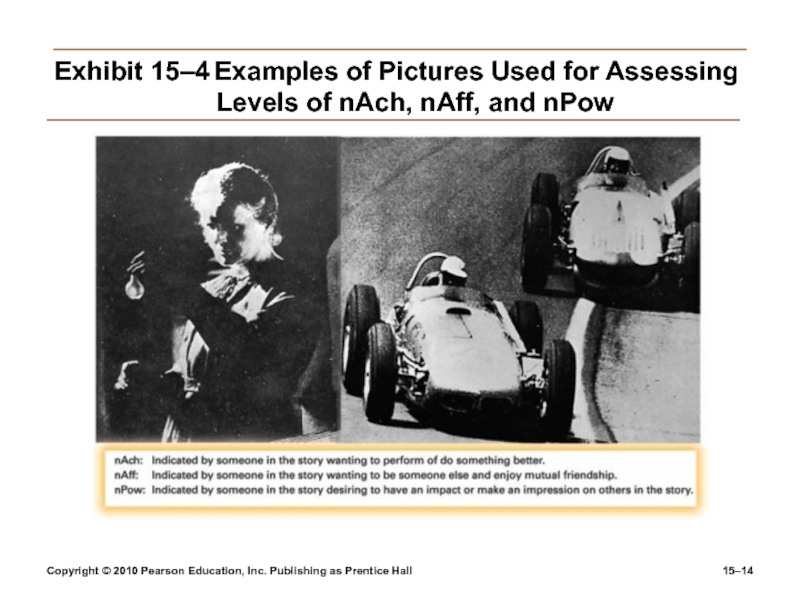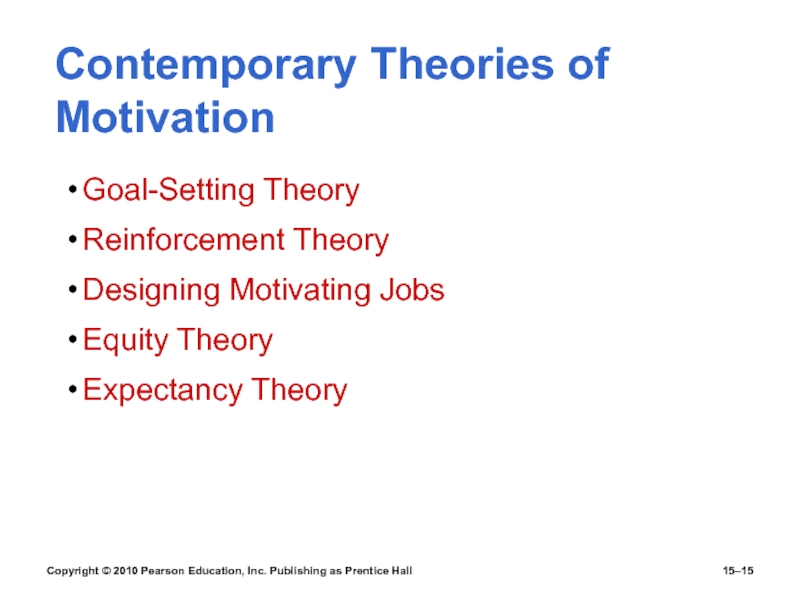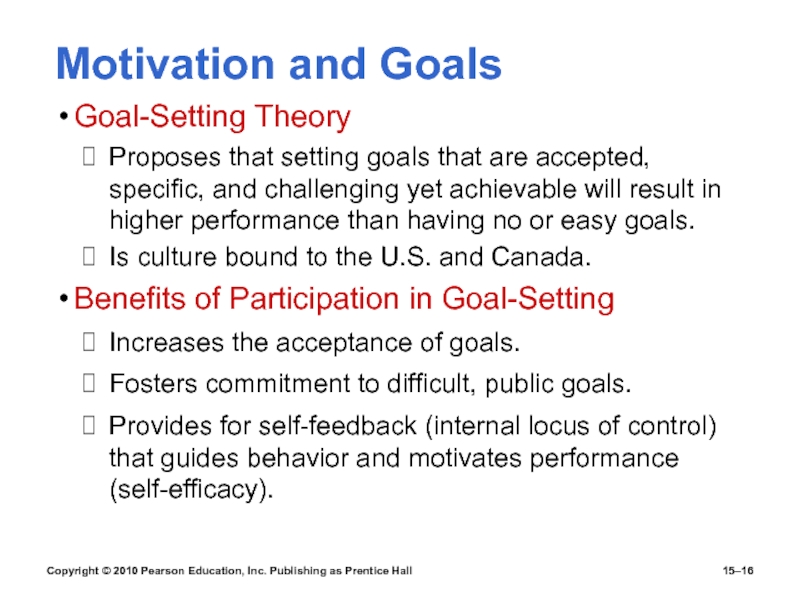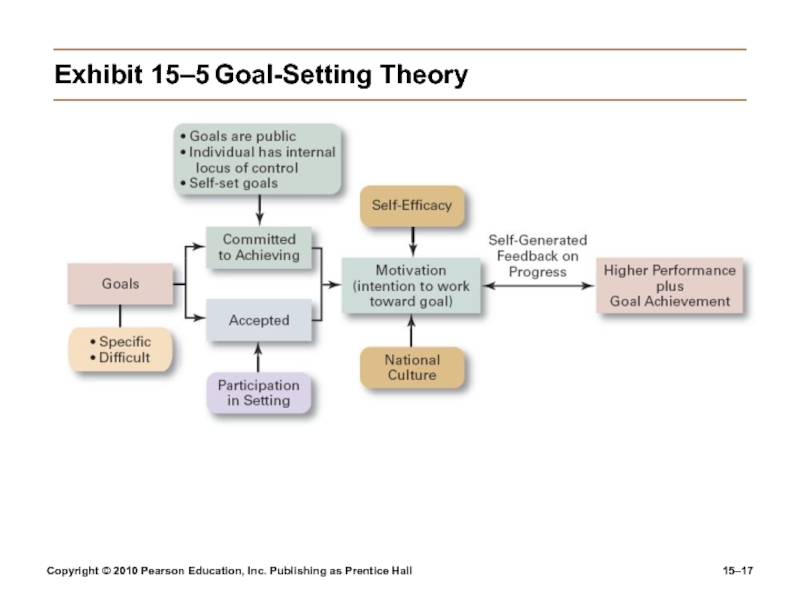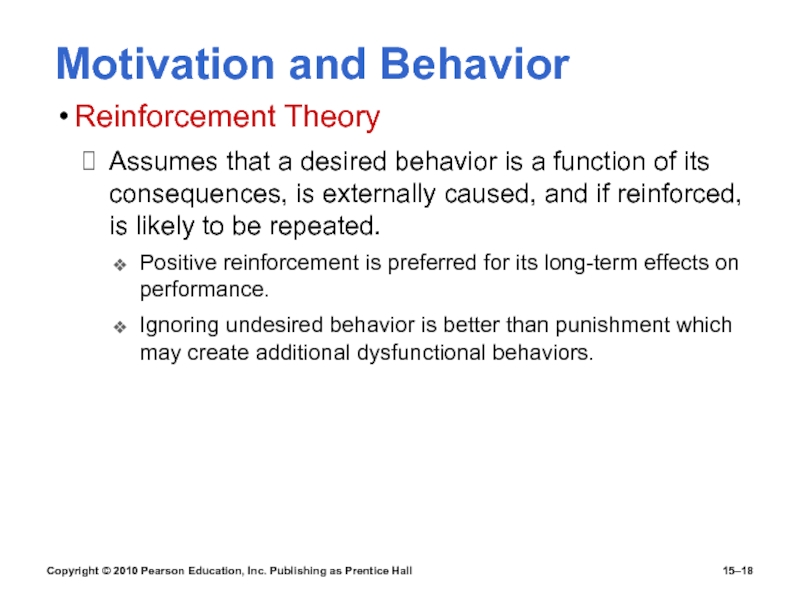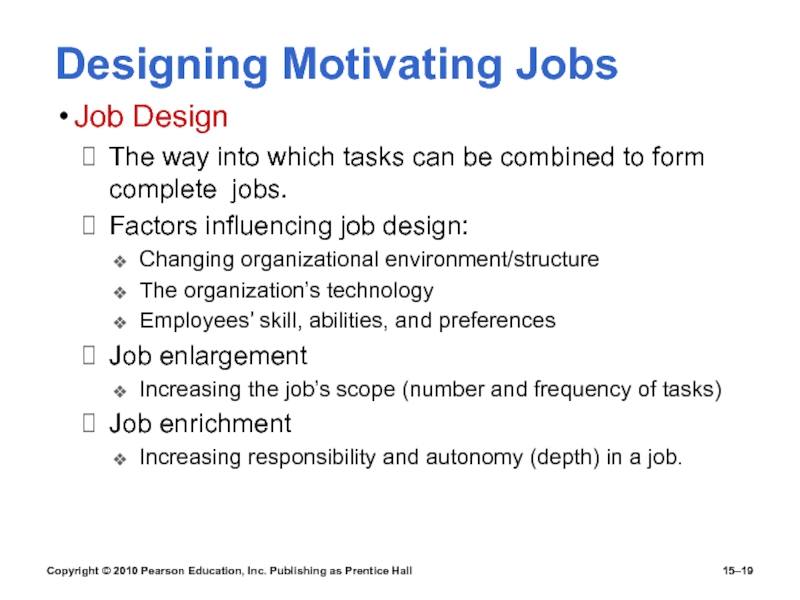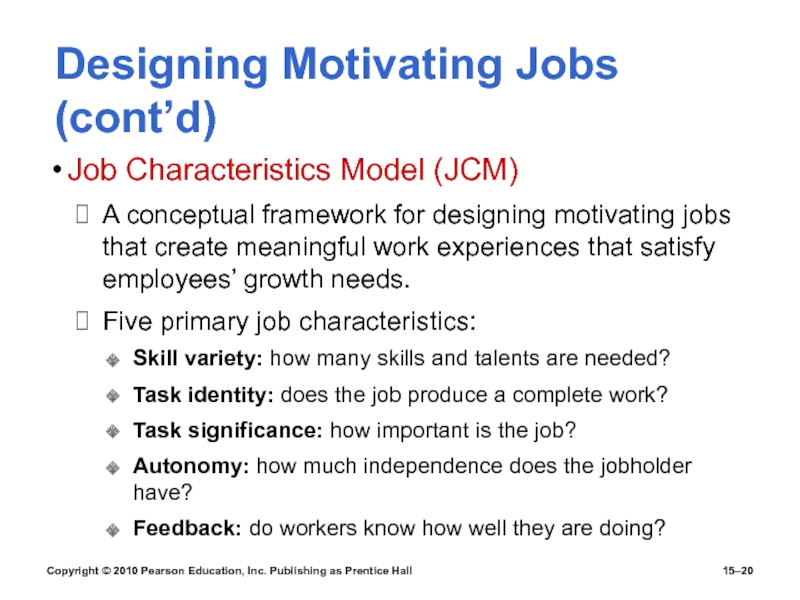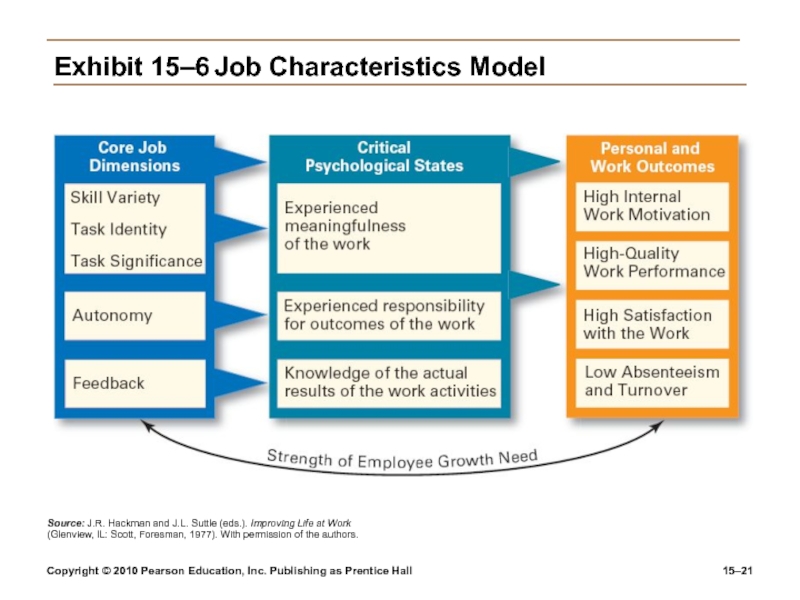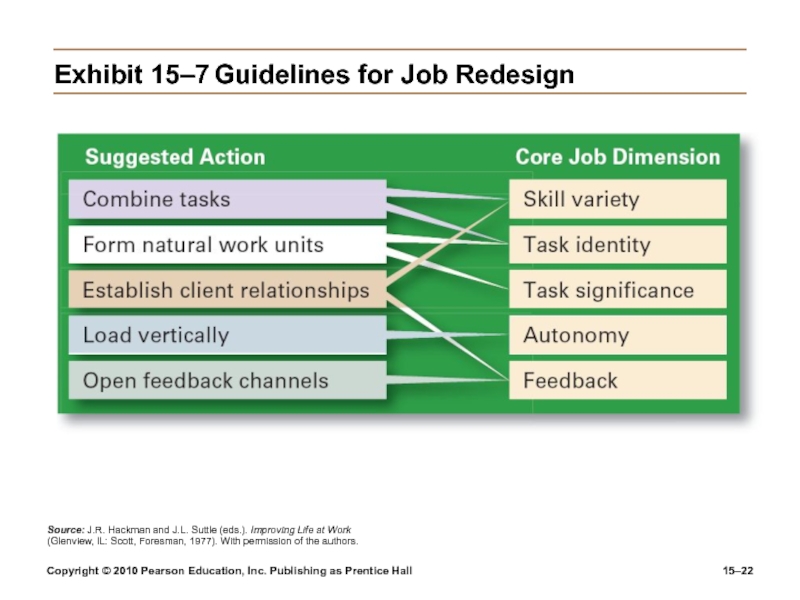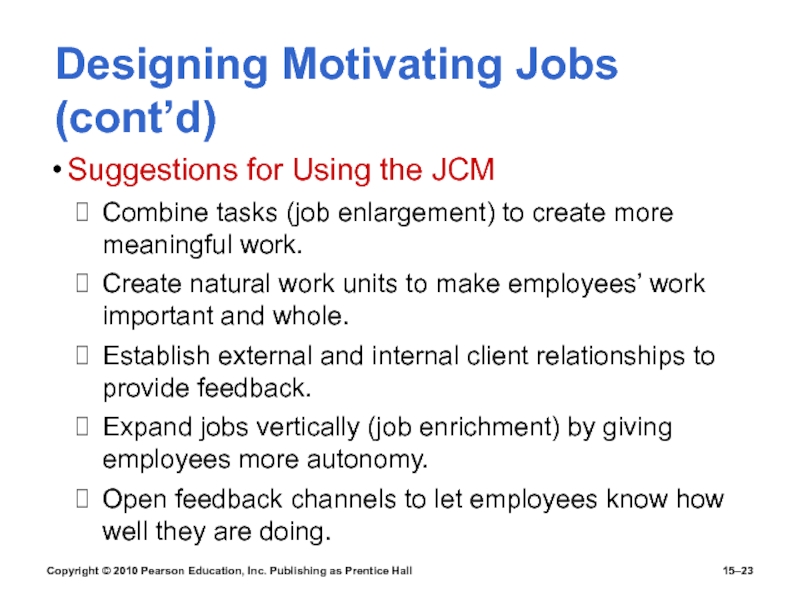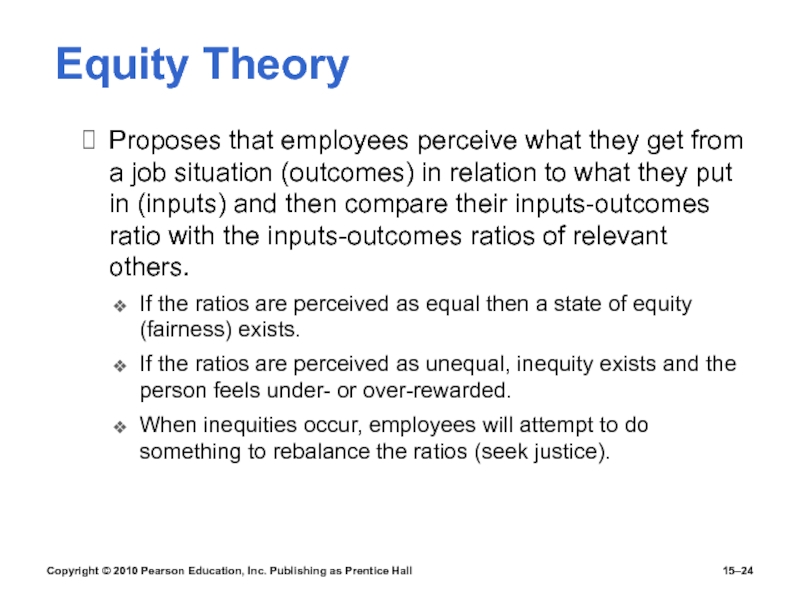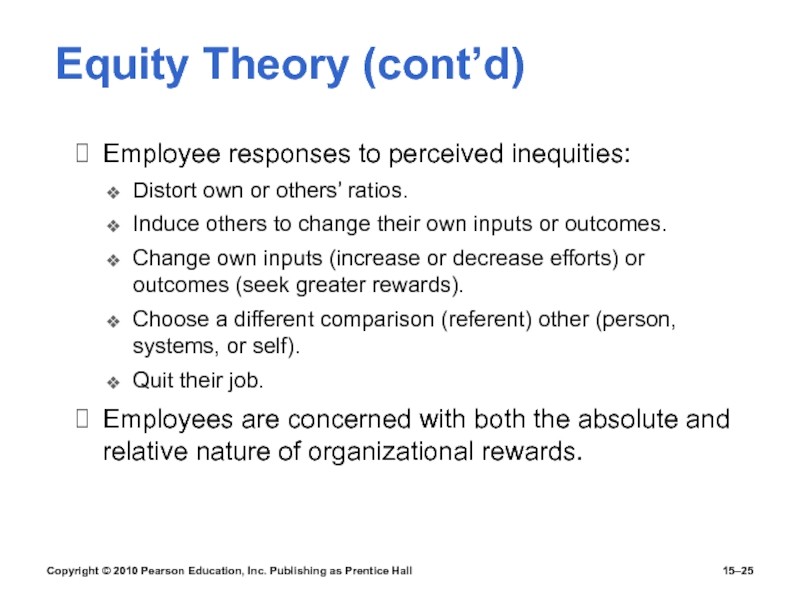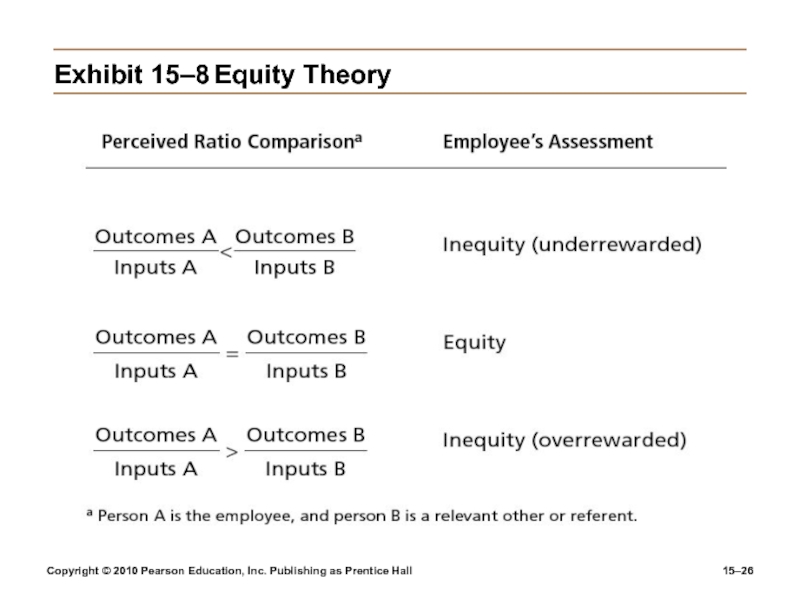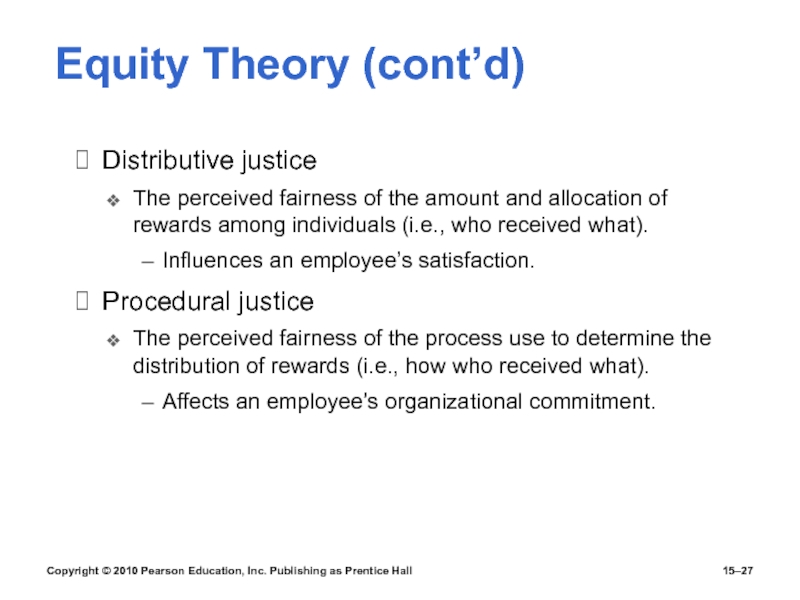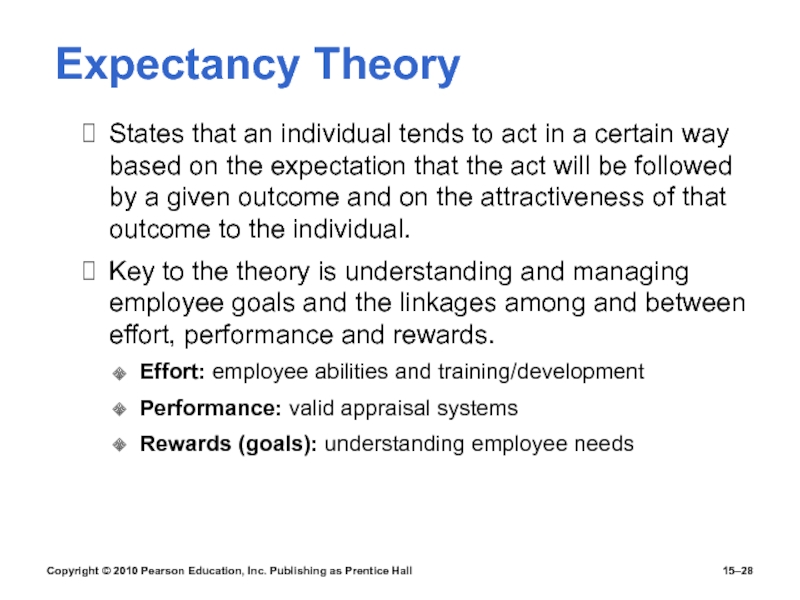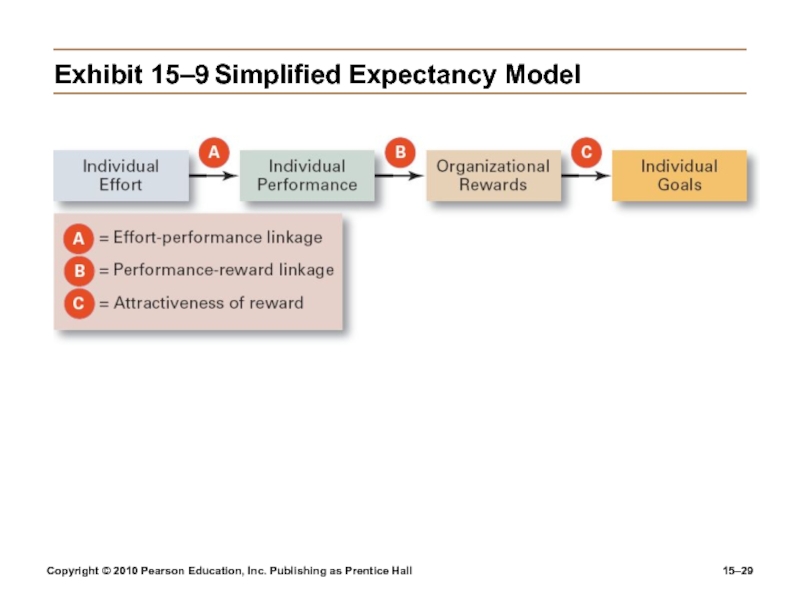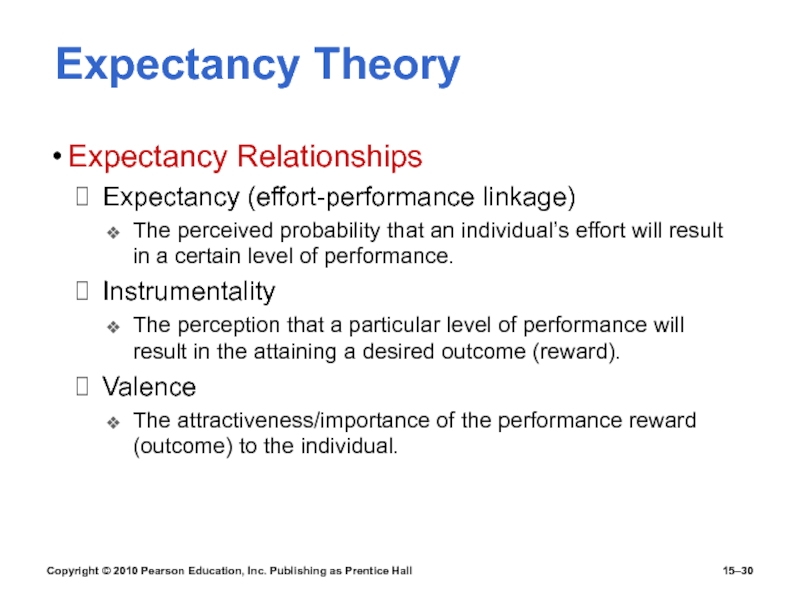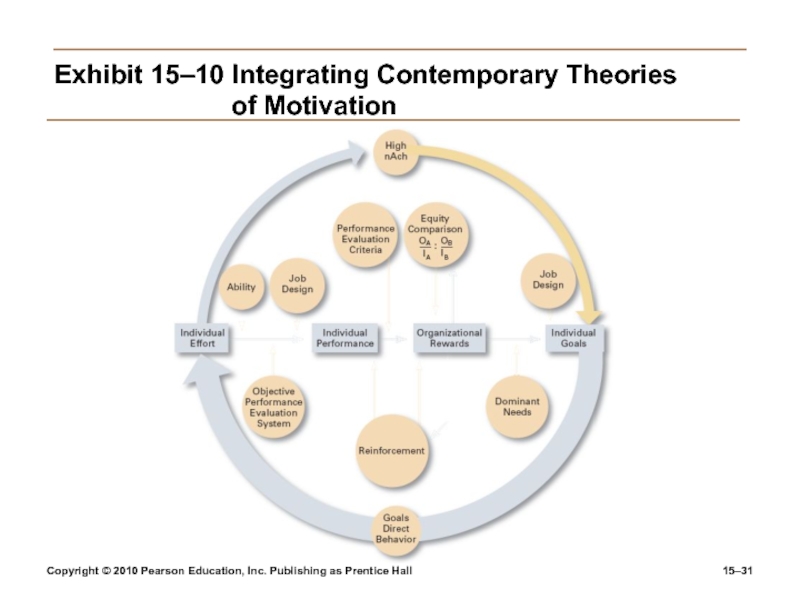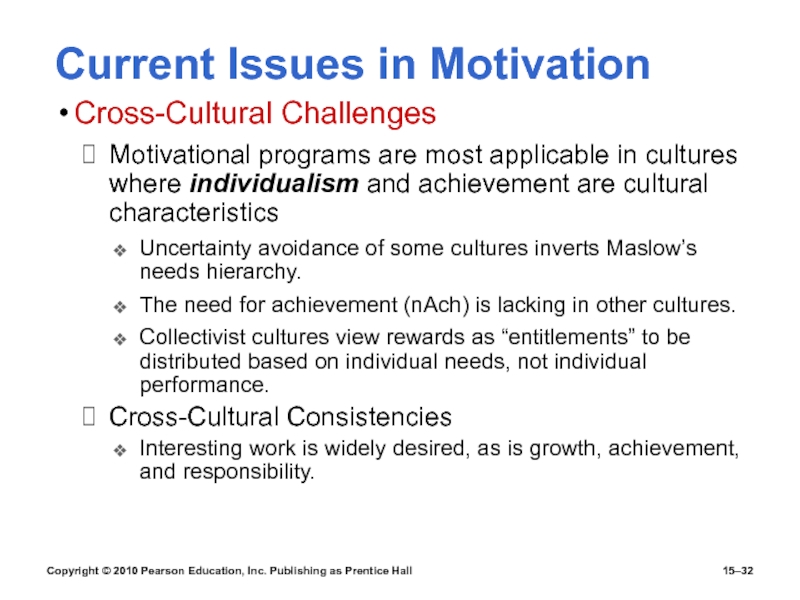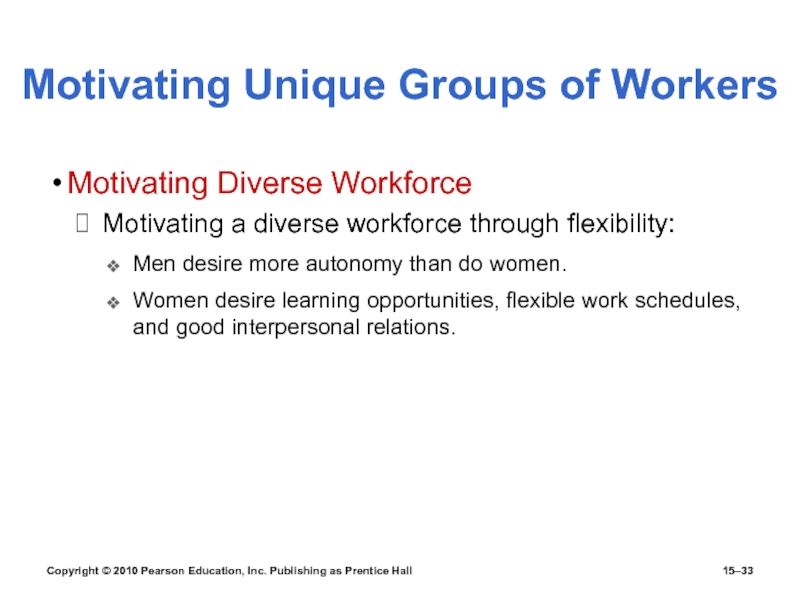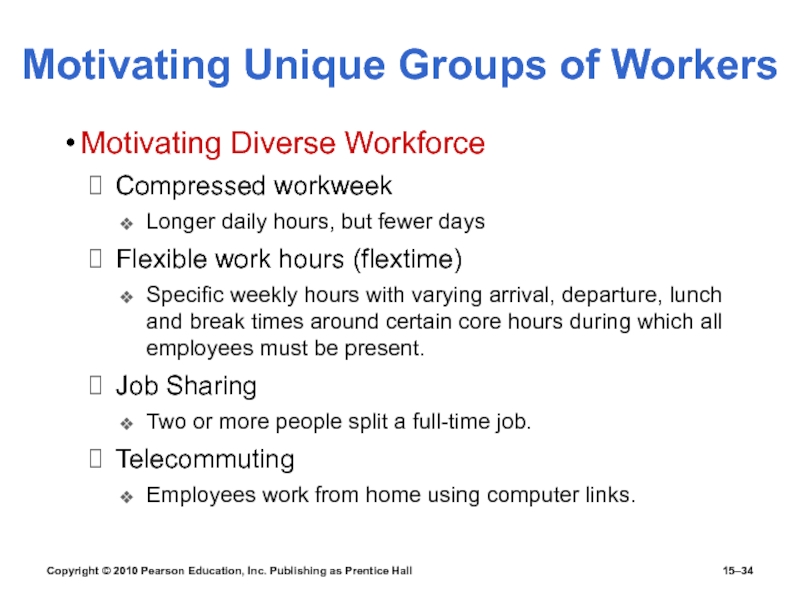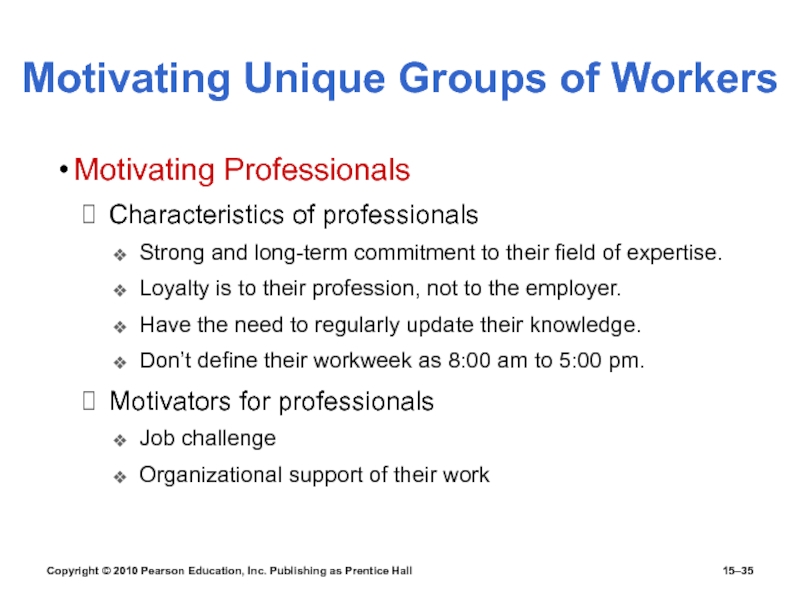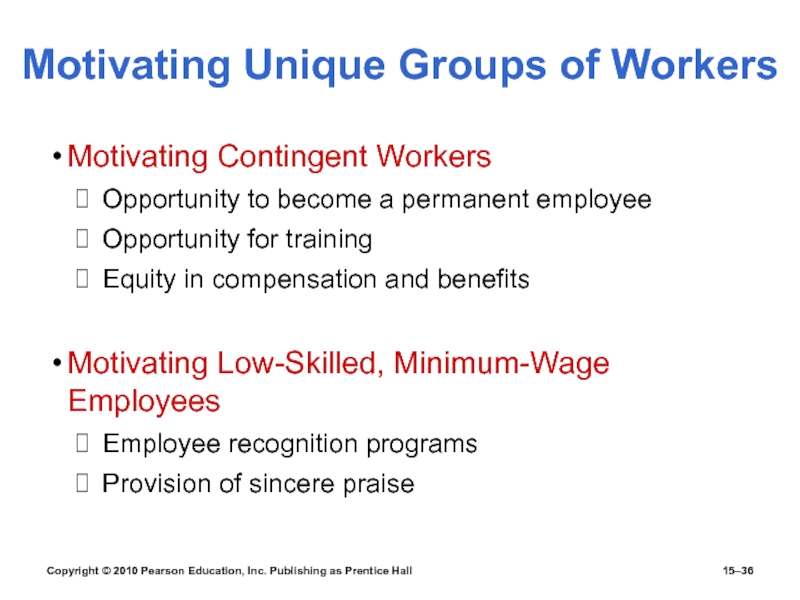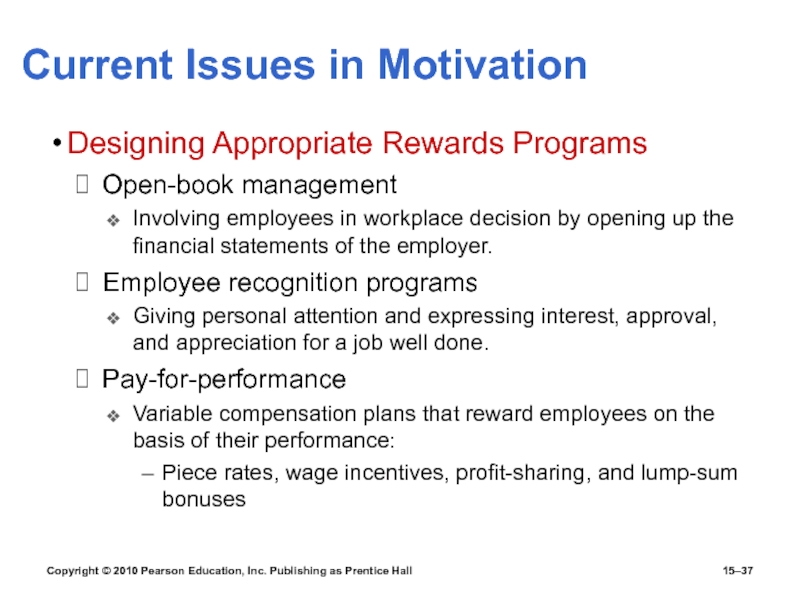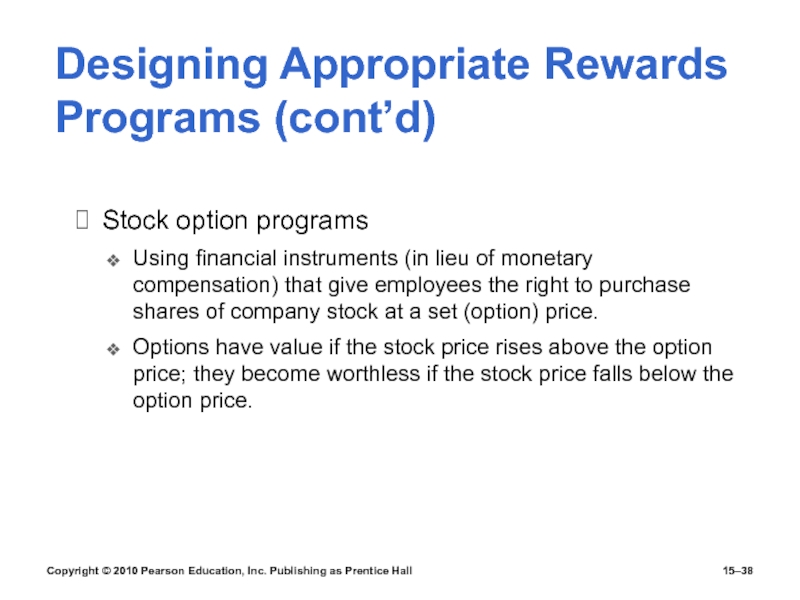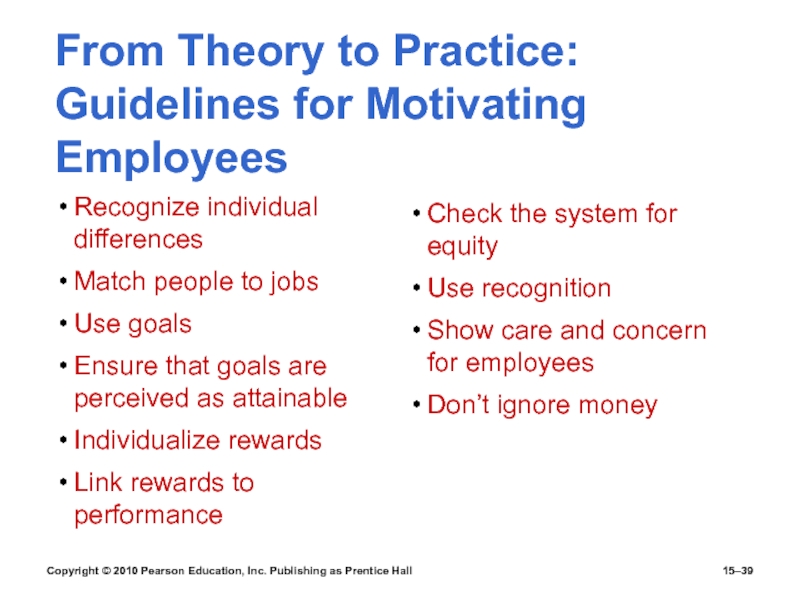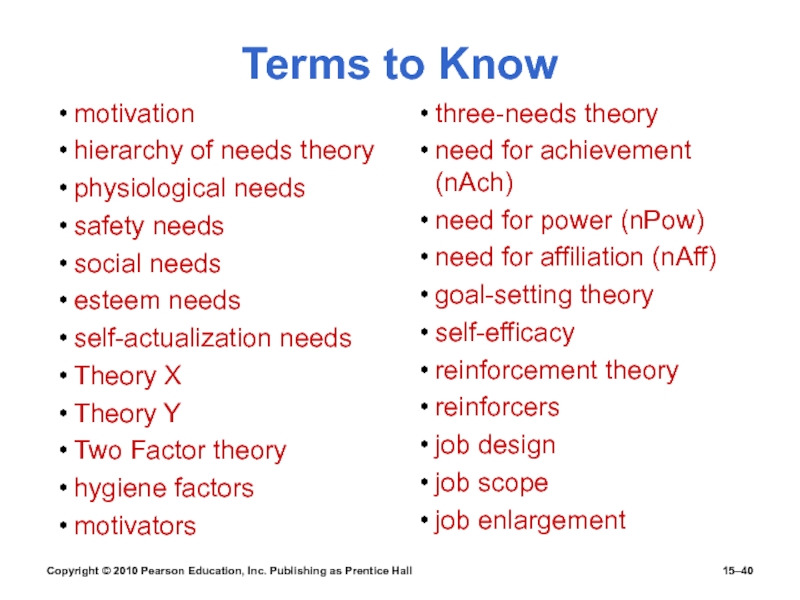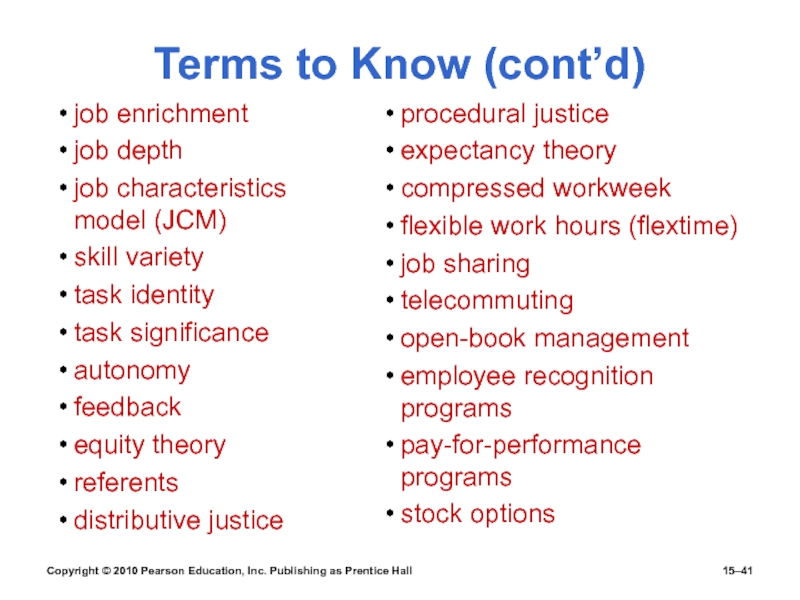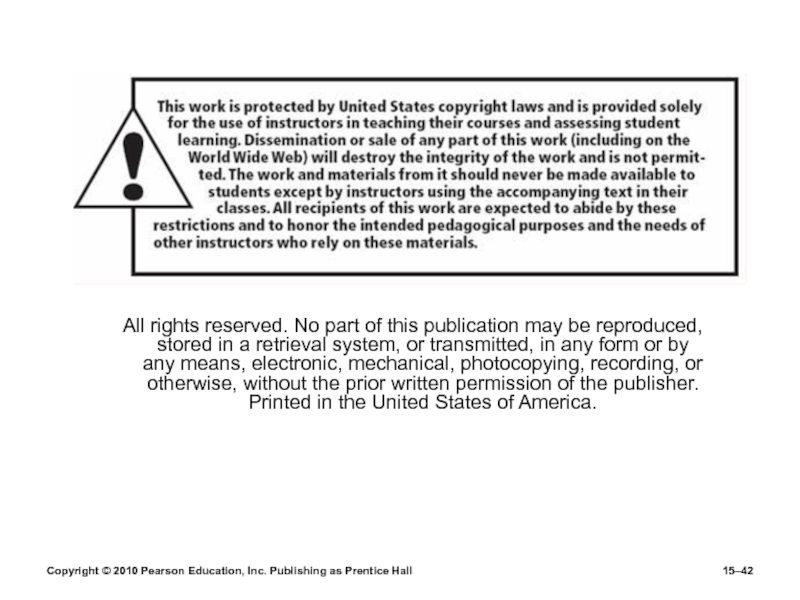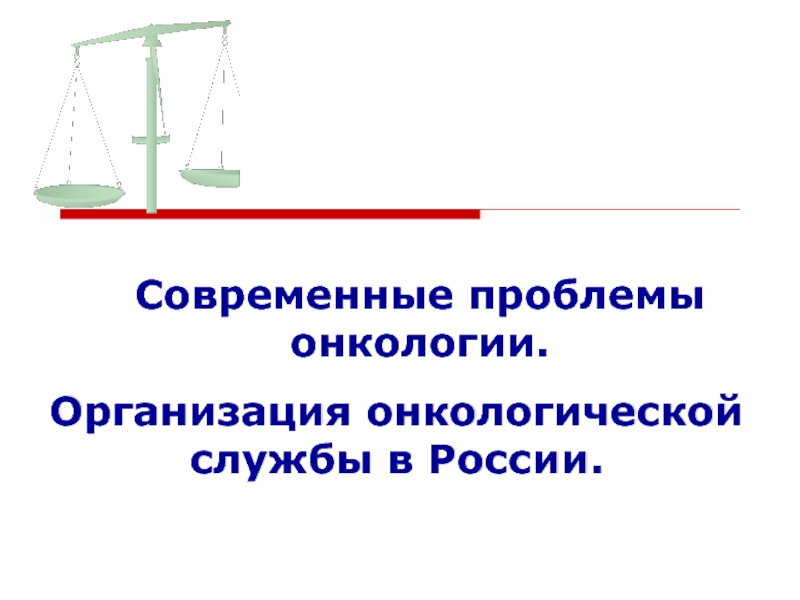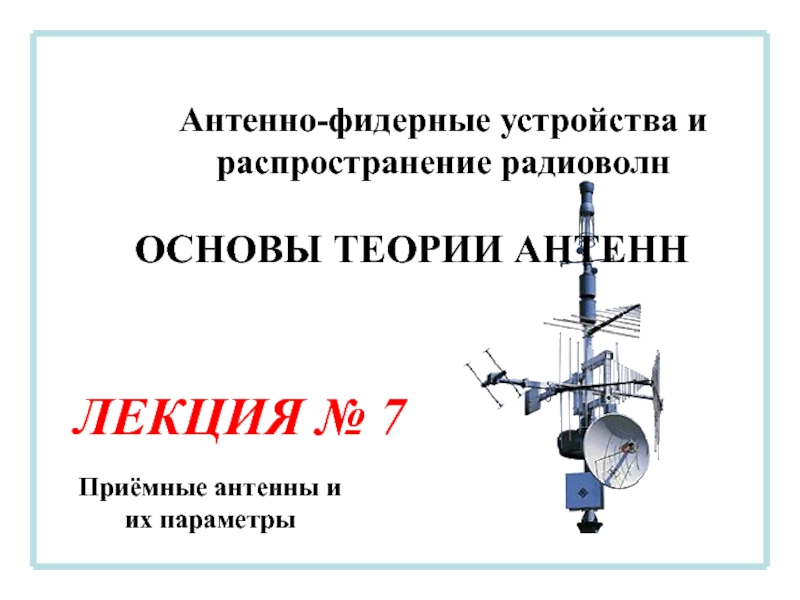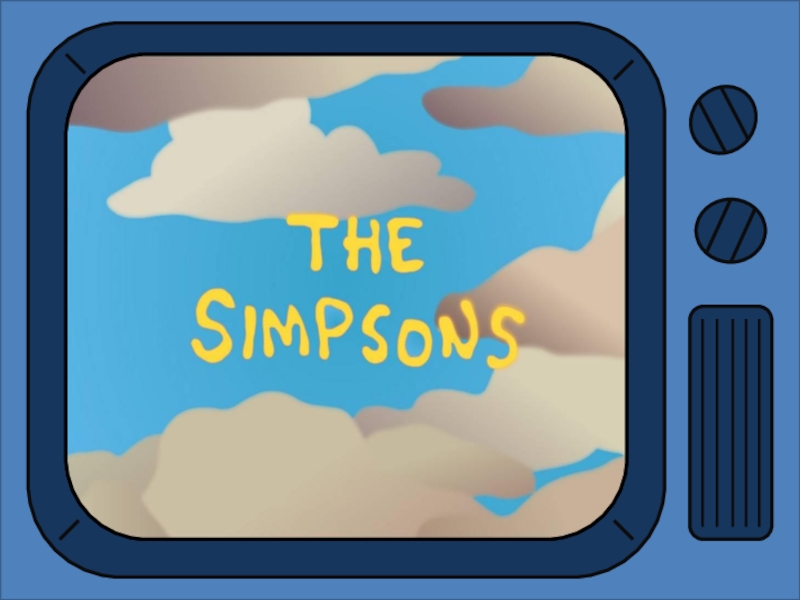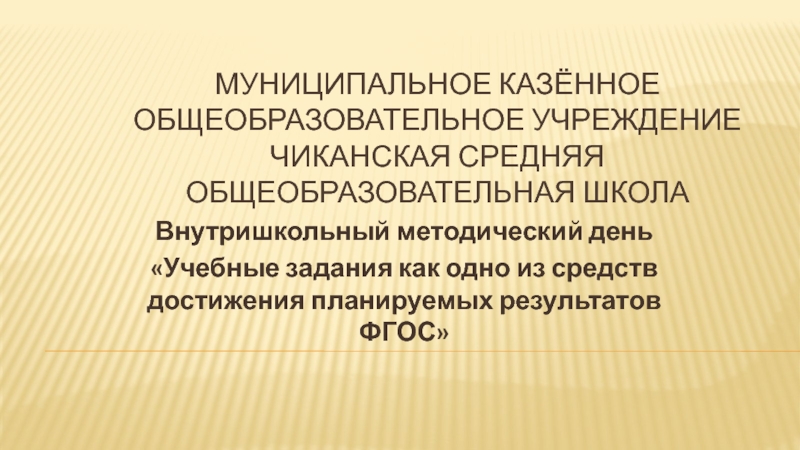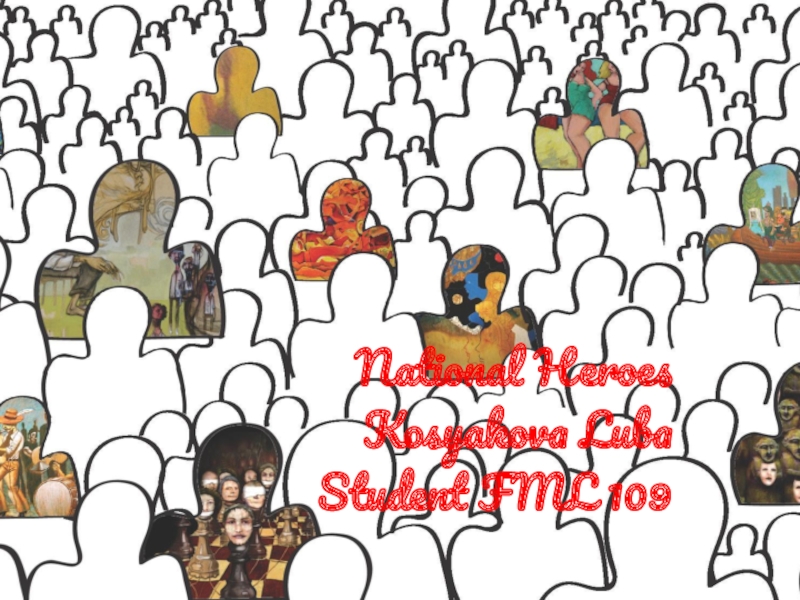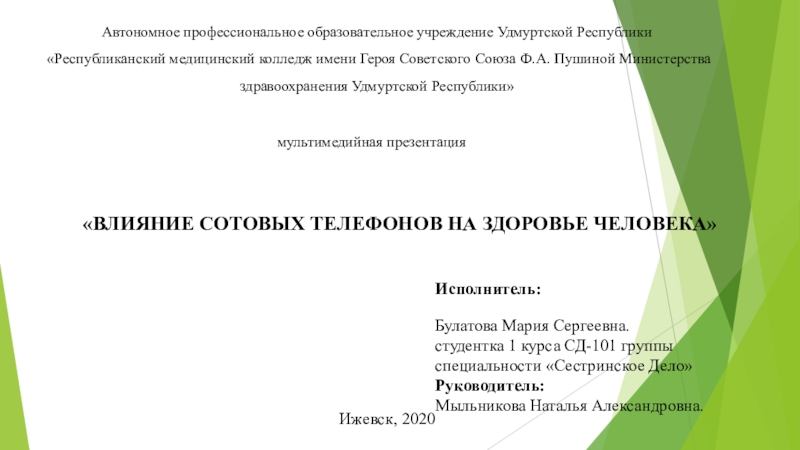Разделы презентаций
- Разное
- Английский язык
- Астрономия
- Алгебра
- Биология
- География
- Геометрия
- Детские презентации
- Информатика
- История
- Литература
- Математика
- Медицина
- Менеджмент
- Музыка
- МХК
- Немецкий язык
- ОБЖ
- Обществознание
- Окружающий мир
- Педагогика
- Русский язык
- Технология
- Физика
- Философия
- Химия
- Шаблоны, картинки для презентаций
- Экология
- Экономика
- Юриспруденция
Motivating Employees
Содержание
- 1. Motivating Employees
- 2. Copyright © 2010 Pearson Education, Inc. Publishing
- 3. Copyright © 2010 Pearson Education, Inc. Publishing
- 4. Copyright © 2010 Pearson Education, Inc. Publishing
- 5. Copyright © 2010 Pearson Education, Inc. Publishing
- 6. Copyright © 2010 Pearson Education, Inc. Publishing
- 7. Copyright © 2010 Pearson Education, Inc. Publishing
- 8. Copyright © 2010 Pearson Education, Inc. Publishing as Prentice Hall15–Exhibit 15–1 Maslow’s Hierarchy of Needs
- 9. Copyright © 2010 Pearson Education, Inc. Publishing
- 10. Copyright © 2010 Pearson Education, Inc. Publishing
- 11. Copyright © 2010 Pearson Education, Inc. Publishing as Prentice Hall15–Exhibit 15–2 Herzberg’s Motivation-Hygiene Theory
- 12. Copyright © 2010 Pearson Education, Inc. Publishing
- 13. Copyright © 2010 Pearson Education, Inc. Publishing
- 14. Copyright © 2010 Pearson Education, Inc. Publishing
- 15. Copyright © 2010 Pearson Education, Inc. Publishing
- 16. Copyright © 2010 Pearson Education, Inc. Publishing
- 17. Copyright © 2010 Pearson Education, Inc. Publishing as Prentice Hall15–Exhibit 15–5 Goal-Setting Theory
- 18. Copyright © 2010 Pearson Education, Inc. Publishing
- 19. Copyright © 2010 Pearson Education, Inc. Publishing
- 20. Copyright © 2010 Pearson Education, Inc. Publishing
- 21. Copyright © 2010 Pearson Education, Inc. Publishing
- 22. Copyright © 2010 Pearson Education, Inc. Publishing
- 23. Copyright © 2010 Pearson Education, Inc. Publishing
- 24. Copyright © 2010 Pearson Education, Inc. Publishing
- 25. Copyright © 2010 Pearson Education, Inc. Publishing
- 26. Copyright © 2010 Pearson Education, Inc. Publishing as Prentice Hall15–Exhibit 15–8 Equity Theory
- 27. Copyright © 2010 Pearson Education, Inc. Publishing
- 28. Copyright © 2010 Pearson Education, Inc. Publishing
- 29. Copyright © 2010 Pearson Education, Inc. Publishing as Prentice Hall15–Exhibit 15–9 Simplified Expectancy Model
- 30. Copyright © 2010 Pearson Education, Inc. Publishing
- 31. Copyright © 2010 Pearson Education, Inc. Publishing
- 32. Copyright © 2010 Pearson Education, Inc. Publishing
- 33. Copyright © 2010 Pearson Education, Inc. Publishing
- 34. Copyright © 2010 Pearson Education, Inc. Publishing
- 35. Copyright © 2010 Pearson Education, Inc. Publishing
- 36. Copyright © 2010 Pearson Education, Inc. Publishing
- 37. Copyright © 2010 Pearson Education, Inc. Publishing
- 38. Copyright © 2010 Pearson Education, Inc. Publishing
- 39. Copyright © 2010 Pearson Education, Inc. Publishing
- 40. Copyright © 2010 Pearson Education, Inc. Publishing
- 41. Copyright © 2010 Pearson Education, Inc. Publishing
- 42. Copyright © 2010 Pearson Education, Inc. Publishing
- 43. Скачать презентанцию
Слайды и текст этой презентации
Слайд 2Copyright © 2010 Pearson Education, Inc. Publishing as Prentice Hall
15–
Learning
Outcomes Follow this Learning Outline as you read and study this
chapter.15.1 What Is Motivation?
Define motivation.
Explain the three key elements of motivation.
15.2 Early Theories of Motivation
Describe Maslow’s hierarchy of needs and how it can be used to motivate.
Discuss how Theory X and Theory Y managers approach motivation.
Describe Herzberg’s motivation-hygiene theory.
Describe the three-needs theory.
Слайд 3Copyright © 2010 Pearson Education, Inc. Publishing as Prentice Hall
15–
Learning
Outcomes
15.3 Contemporary Theories of Motivation
Explain how goal-setting and reinforcement theories
explain employee motivation.Describe job design approaches to motivation.
Discuss the motivation implications of equity theory.
Explain the three key linkages in expectancy theory and their role in motivation.
Слайд 4Copyright © 2010 Pearson Education, Inc. Publishing as Prentice Hall
15–
Learning
Outcomes
15.4 Current Issues in Motivation
Describe the cross-cultural challenges of motivation.
Discuss
the challenges managers face in motivating unique groups of workers.Describe open-book management, employee recognition, pay-for-performance, and stock option programs.
Слайд 5Copyright © 2010 Pearson Education, Inc. Publishing as Prentice Hall
15–
What
Is Motivation?
Motivation
Is the result of an interaction between the person
and a situation; it is not a personal trait.Is the process by which a person’s efforts are energized, directed, and sustained towards attaining a goal.
Energy: a measure of intensity or drive.
Direction: toward organizational goals
Persistence: exerting effort to achieve goals.
Motivation works best when individual needs are compatible with organizational goals.
Слайд 6Copyright © 2010 Pearson Education, Inc. Publishing as Prentice Hall
15–
Early
Theories of Motivation
Maslow’s Hierarchy of Needs
McGregor’s Theories X and Y
Herzberg’s
Two-Factor TheoryMcClelland’s Three Needs Theory
Слайд 7Copyright © 2010 Pearson Education, Inc. Publishing as Prentice Hall
15–
Early
Theories of Motivation
Maslow’s Hierarchy of Needs Theory
Needs were categorized as
five levels of lower- to higher-order needs.Individuals must satisfy lower-order needs before they can satisfy higher order needs.
Satisfied needs will no longer motivate.
Motivating a person depends on knowing at what level that person is on the hierarchy.
Hierarchy of needs
Lower-order (external): physiological, safety
Higher-order (internal): social, esteem, self-actualization
Слайд 8Copyright © 2010 Pearson Education, Inc. Publishing as Prentice Hall
15–
Exhibit
15–1 Maslow’s Hierarchy of Needs
Слайд 9Copyright © 2010 Pearson Education, Inc. Publishing as Prentice Hall
15–
Early
Theories of Motivation (cont’d)
McGregor’s Theory X and Theory Y
Theory X
Assumes
that workers have little ambition, dislike work, avoid responsibility, and require close supervision.Theory Y
Assumes that workers can exercise self-direction, desire responsibility, and like to work.
Assumption:
Motivation is maximized by participative decision making, interesting jobs, and good group relations.
Слайд 10Copyright © 2010 Pearson Education, Inc. Publishing as Prentice Hall
15–
Early
Theories of Motivation (cont’d)
Herzberg’s Motivation-Hygiene Theory
Job satisfaction and job dissatisfaction
are created by different factors.Hygiene factors: extrinsic (environmental) factors that create job dissatisfaction.
Motivators: intrinsic (psychological) factors that create job satisfaction.
Attempted to explain why job satisfaction does not result in increased performance.
The opposite of satisfaction is not dissatisfaction, but rather no satisfaction.
Слайд 11Copyright © 2010 Pearson Education, Inc. Publishing as Prentice Hall
15–
Exhibit
15–2 Herzberg’s Motivation-Hygiene Theory
Слайд 12Copyright © 2010 Pearson Education, Inc. Publishing as Prentice Hall
15–
Exhibit
15–3 Contrasting Views of Satisfaction-
Dissatisfaction
Слайд 13Copyright © 2010 Pearson Education, Inc. Publishing as Prentice Hall
15–
Motivation
and Needs
Three-Needs Theory (McClelland)
There are three major acquired needs that
are major motives in work.Need for achievement (nAch)
The drive to excel and succeed
Need for power (nPow)
The need to influence the behavior of others
Need of affiliation (nAff)
The desire for interpersonal relationships
Слайд 14Copyright © 2010 Pearson Education, Inc. Publishing as Prentice Hall
15–
Exhibit
15–4 Examples of Pictures Used for Assessing Levels of
nAch, nAff, and nPowСлайд 15Copyright © 2010 Pearson Education, Inc. Publishing as Prentice Hall
15–
Contemporary
Theories of Motivation
Goal-Setting Theory
Reinforcement Theory
Designing Motivating Jobs
Equity Theory
Expectancy Theory
Слайд 16Copyright © 2010 Pearson Education, Inc. Publishing as Prentice Hall
15–
Motivation
and Goals
Goal-Setting Theory
Proposes that setting goals that are accepted, specific,
and challenging yet achievable will result in higher performance than having no or easy goals.Is culture bound to the U.S. and Canada.
Benefits of Participation in Goal-Setting
Increases the acceptance of goals.
Fosters commitment to difficult, public goals.
Provides for self-feedback (internal locus of control) that guides behavior and motivates performance (self-efficacy).
Слайд 17Copyright © 2010 Pearson Education, Inc. Publishing as Prentice Hall
15–
Exhibit
15–5 Goal-Setting Theory
Слайд 18Copyright © 2010 Pearson Education, Inc. Publishing as Prentice Hall
15–
Motivation
and Behavior
Reinforcement Theory
Assumes that a desired behavior is a function
of its consequences, is externally caused, and if reinforced, is likely to be repeated.Positive reinforcement is preferred for its long-term effects on performance.
Ignoring undesired behavior is better than punishment which may create additional dysfunctional behaviors.
Слайд 19Copyright © 2010 Pearson Education, Inc. Publishing as Prentice Hall
15–
Designing
Motivating Jobs
Job Design
The way into which tasks can be combined
to form complete jobs.Factors influencing job design:
Changing organizational environment/structure
The organization’s technology
Employees’ skill, abilities, and preferences
Job enlargement
Increasing the job’s scope (number and frequency of tasks)
Job enrichment
Increasing responsibility and autonomy (depth) in a job.
Слайд 20Copyright © 2010 Pearson Education, Inc. Publishing as Prentice Hall
15–
Designing
Motivating Jobs (cont’d)
Job Characteristics Model (JCM)
A conceptual framework for designing
motivating jobs that create meaningful work experiences that satisfy employees’ growth needs.Five primary job characteristics:
Skill variety: how many skills and talents are needed?
Task identity: does the job produce a complete work?
Task significance: how important is the job?
Autonomy: how much independence does the jobholder have?
Feedback: do workers know how well they are doing?
Слайд 21Copyright © 2010 Pearson Education, Inc. Publishing as Prentice Hall
15–
Exhibit
15–6 Job Characteristics Model
Source: J.R. Hackman and J.L. Suttle (eds.). Improving
Life at Work (Glenview, IL: Scott, Foresman, 1977). With permission of the authors.Слайд 22Copyright © 2010 Pearson Education, Inc. Publishing as Prentice Hall
15–
Exhibit
15–7 Guidelines for Job Redesign
Source: J.R. Hackman and J.L. Suttle (eds.).
Improving Life at Work (Glenview, IL: Scott, Foresman, 1977). With permission of the authors.Слайд 23Copyright © 2010 Pearson Education, Inc. Publishing as Prentice Hall
15–
Designing
Motivating Jobs (cont’d)
Suggestions for Using the JCM
Combine tasks (job enlargement)
to create more meaningful work.Create natural work units to make employees’ work important and whole.
Establish external and internal client relationships to provide feedback.
Expand jobs vertically (job enrichment) by giving employees more autonomy.
Open feedback channels to let employees know how well they are doing.
Слайд 24Copyright © 2010 Pearson Education, Inc. Publishing as Prentice Hall
15–
Equity
Theory
Proposes that employees perceive what they get from a job
situation (outcomes) in relation to what they put in (inputs) and then compare their inputs-outcomes ratio with the inputs-outcomes ratios of relevant others.If the ratios are perceived as equal then a state of equity (fairness) exists.
If the ratios are perceived as unequal, inequity exists and the person feels under- or over-rewarded.
When inequities occur, employees will attempt to do something to rebalance the ratios (seek justice).
Слайд 25Copyright © 2010 Pearson Education, Inc. Publishing as Prentice Hall
15–
Equity
Theory (cont’d)
Employee responses to perceived inequities:
Distort own or others’
ratios.Induce others to change their own inputs or outcomes.
Change own inputs (increase or decrease efforts) or outcomes (seek greater rewards).
Choose a different comparison (referent) other (person, systems, or self).
Quit their job.
Employees are concerned with both the absolute and relative nature of organizational rewards.
Слайд 26Copyright © 2010 Pearson Education, Inc. Publishing as Prentice Hall
15–
Exhibit
15–8 Equity Theory
Слайд 27Copyright © 2010 Pearson Education, Inc. Publishing as Prentice Hall
15–
Equity
Theory (cont’d)
Distributive justice
The perceived fairness of the amount and allocation
of rewards among individuals (i.e., who received what).Influences an employee’s satisfaction.
Procedural justice
The perceived fairness of the process use to determine the distribution of rewards (i.e., how who received what).
Affects an employee’s organizational commitment.
Слайд 28Copyright © 2010 Pearson Education, Inc. Publishing as Prentice Hall
15–
Expectancy
Theory
States that an individual tends to act in a certain
way based on the expectation that the act will be followed by a given outcome and on the attractiveness of that outcome to the individual.Key to the theory is understanding and managing employee goals and the linkages among and between effort, performance and rewards.
Effort: employee abilities and training/development
Performance: valid appraisal systems
Rewards (goals): understanding employee needs
Слайд 29Copyright © 2010 Pearson Education, Inc. Publishing as Prentice Hall
15–
Exhibit
15–9 Simplified Expectancy Model
Слайд 30Copyright © 2010 Pearson Education, Inc. Publishing as Prentice Hall
15–
Expectancy
Theory
Expectancy Relationships
Expectancy (effort-performance linkage)
The perceived probability that an individual’s
effort will result in a certain level of performance.Instrumentality
The perception that a particular level of performance will result in the attaining a desired outcome (reward).
Valence
The attractiveness/importance of the performance reward (outcome) to the individual.
Слайд 31Copyright © 2010 Pearson Education, Inc. Publishing as Prentice Hall
15–
Exhibit
15–10 Integrating Contemporary Theories
of MotivationСлайд 32Copyright © 2010 Pearson Education, Inc. Publishing as Prentice Hall
15–
Current
Issues in Motivation
Cross-Cultural Challenges
Motivational programs are most applicable in cultures
where individualism and achievement are cultural characteristicsUncertainty avoidance of some cultures inverts Maslow’s needs hierarchy.
The need for achievement (nAch) is lacking in other cultures.
Collectivist cultures view rewards as “entitlements” to be distributed based on individual needs, not individual performance.
Cross-Cultural Consistencies
Interesting work is widely desired, as is growth, achievement, and responsibility.
Слайд 33Copyright © 2010 Pearson Education, Inc. Publishing as Prentice Hall
15–
Motivating
Diverse Workforce
Motivating a diverse workforce through flexibility:
Men desire more
autonomy than do women.Women desire learning opportunities, flexible work schedules, and good interpersonal relations.
Motivating Unique Groups of Workers
Слайд 34Copyright © 2010 Pearson Education, Inc. Publishing as Prentice Hall
15–
Motivating
Unique Groups of Workers
Motivating Diverse Workforce
Compressed workweek
Longer daily hours, but
fewer daysFlexible work hours (flextime)
Specific weekly hours with varying arrival, departure, lunch and break times around certain core hours during which all employees must be present.
Job Sharing
Two or more people split a full-time job.
Telecommuting
Employees work from home using computer links.
Слайд 35Copyright © 2010 Pearson Education, Inc. Publishing as Prentice Hall
15–
Motivating
Professionals
Characteristics of professionals
Strong and long-term commitment to their field of
expertise.Loyalty is to their profession, not to the employer.
Have the need to regularly update their knowledge.
Don’t define their workweek as 8:00 am to 5:00 pm.
Motivators for professionals
Job challenge
Organizational support of their work
Motivating Unique Groups of Workers
Слайд 36Copyright © 2010 Pearson Education, Inc. Publishing as Prentice Hall
15–
Motivating
Contingent Workers
Opportunity to become a permanent employee
Opportunity for training
Equity in
compensation and benefitsMotivating Low-Skilled, Minimum-Wage Employees
Employee recognition programs
Provision of sincere praise
Motivating Unique Groups of Workers
Слайд 37Copyright © 2010 Pearson Education, Inc. Publishing as Prentice Hall
15–
Designing
Appropriate Rewards Programs
Open-book management
Involving employees in workplace decision by opening
up the financial statements of the employer.Employee recognition programs
Giving personal attention and expressing interest, approval, and appreciation for a job well done.
Pay-for-performance
Variable compensation plans that reward employees on the basis of their performance:
Piece rates, wage incentives, profit-sharing, and lump-sum bonuses
Current Issues in Motivation
Слайд 38Copyright © 2010 Pearson Education, Inc. Publishing as Prentice Hall
15–
Designing
Appropriate Rewards Programs (cont’d)
Stock option programs
Using financial instruments (in lieu
of monetary compensation) that give employees the right to purchase shares of company stock at a set (option) price.Options have value if the stock price rises above the option price; they become worthless if the stock price falls below the option price.
Слайд 39Copyright © 2010 Pearson Education, Inc. Publishing as Prentice Hall
15–
From
Theory to Practice:
Guidelines for Motivating Employees
Recognize individual differences
Match people
to jobsUse goals
Ensure that goals are perceived as attainable
Individualize rewards
Link rewards to performance
Check the system for equity
Use recognition
Show care and concern for employees
Don’t ignore money
Слайд 40Copyright © 2010 Pearson Education, Inc. Publishing as Prentice Hall
15–
Terms
to Know
motivation
hierarchy of needs theory
physiological needs
safety needs
social needs
esteem needs
self-actualization needs
Theory
XTheory Y
Two Factor theory
hygiene factors
motivators
three-needs theory
need for achievement (nAch)
need for power (nPow)
need for affiliation (nAff)
goal-setting theory
self-efficacy
reinforcement theory
reinforcers
job design
job scope
job enlargement
Слайд 41Copyright © 2010 Pearson Education, Inc. Publishing as Prentice Hall
15–
Terms
to Know (cont’d)
job enrichment
job depth
job characteristics model (JCM)
skill variety
task identity
task
significanceautonomy
feedback
equity theory
referents
distributive justice
procedural justice
expectancy theory
compressed workweek
flexible work hours (flextime)
job sharing
telecommuting
open-book management
employee recognition programs
pay-for-performance programs
stock options
